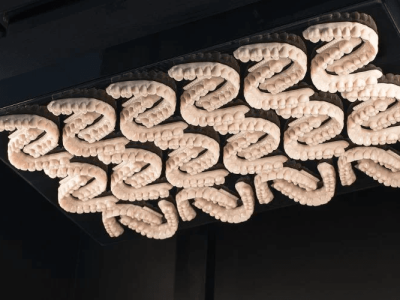Japan: Dental crowns can now be produced more efficiently than traditional milling using digital light processing (DLP) 3D printing, according to research from Japan's Tohoku University Graduate School of Dentistry.

In a recent study, the dentists used the same dataset to 3D print and wet mill crowns before superimposing their desired design over the models produced. The team claims that after numerous testing cycles, their 3D printed dental restorations showed "better precision" and "fewer marginal differences" than milled substitutes; as a result, they view DLP as a more "promising technology" for the fabrication of permanent crowns.

Is it time to move on from milling?
Some dentists are using milling resin-composite dental crowns over conventional metallic restorations as dental materials' wear resistance and color stability continue to advance. This method enables the creation of personalized implants before machining them from a ceramic block using CAD design software and an impression of the patient's teeth.
The Tohoku University team asserts that the technology has drawbacks, including material waste and the corrosion of the milling bar. The researchers also point out that milling frequently requires dentists to follow strict preparation guidelines, and even when they do, grooves can form on the inside surfaces of crowns, resulting in poor patient fit.
The team has acknowledged the potential of the technology for manufacturing models, bases, and splints owing to the R&D being put into novel dental 3D printing resins, including those that have great durability and are capable of dispersing occlusal stress.
The researchers hypothesized that 3D printing produces permanent crowns with "better dimensional accuracy" prior to their study. The dentists argue that it "remains unclear" whether the procedure is better suited for the job even though 3D printed and milled dental prostheses are frequently contrasted. As a result, they set out on their investigation to determine for sure through a series of studies.

Regardless of the abutment shape, DLP-based 3D printing achieved a greater level of dimensional fitting accuracy and excellent trueness. When it comes to milling, the trueness is highly reliant on the qualities of the material. More brittle materials, including ceramics and ceramics with polymer infiltration, are more likely to chip during processing, which means that excessive milling might lead to a lower-quality item.
Additionally, compared to milling, DLP offers a wider achievable range of fitting accuracy.
The researchers emphasized that additional research utilizing various printing parameters and fabrication techniques would be helpful. Future studies might assess the fracture resistance and biocompatibility of 3D-printed crowns as permanent prostheses.
SOURCE: Dental Materials Journal
Read the whole study here: “Comparison of the accuracy of resin-composite crowns fabricated by three-dimensional printing and milling methods”



















Comments